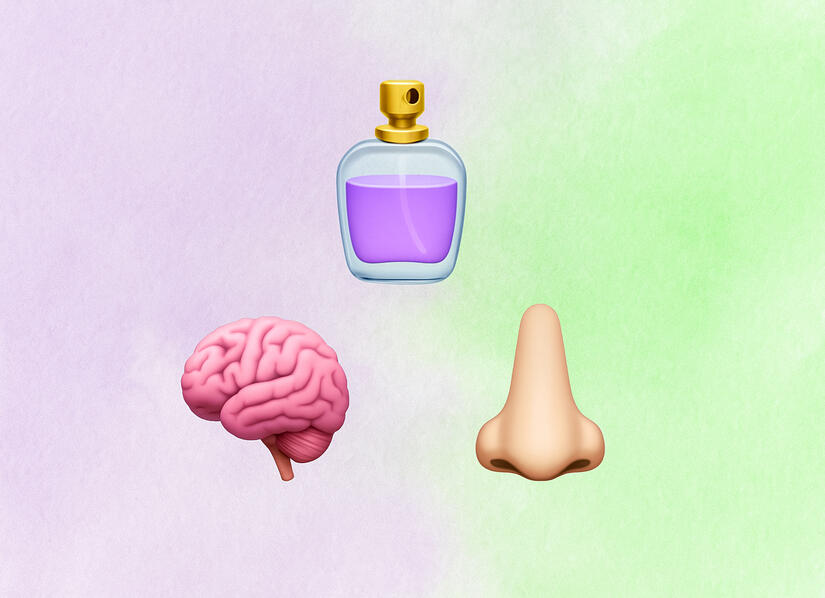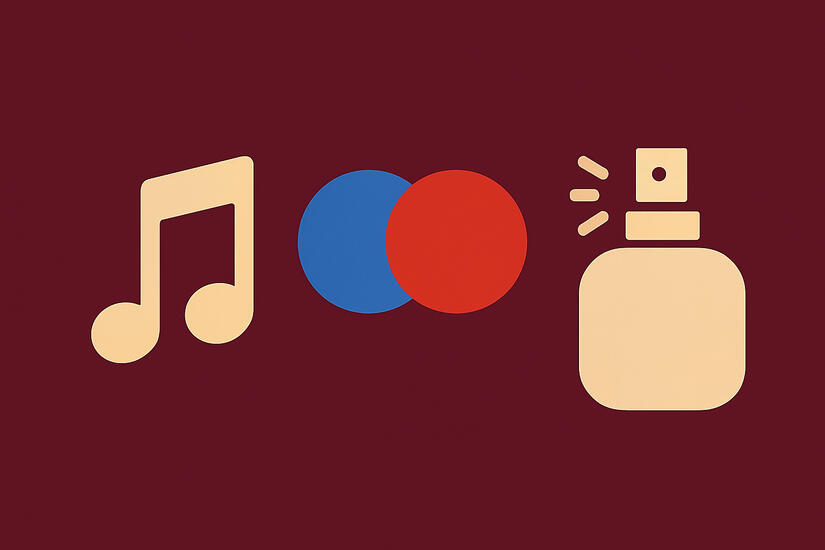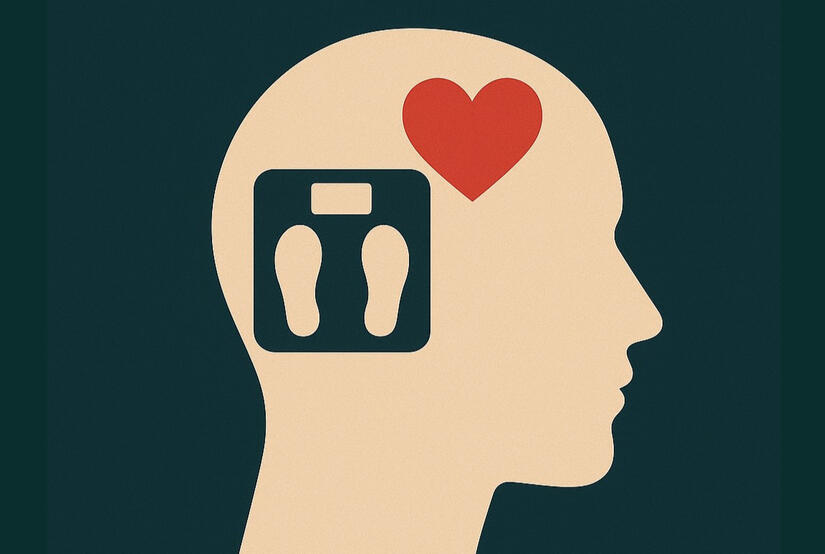
Yağmur Başak Ören
Neuroscience | Olfaction | NeuromarketingExploring how scent shapes emotion, memory, consumer behaviour through the lens of neuroscience and neuromarketing.
About
Yağmur Başak Ören has always been captivated by the power of olfaction and fragrance. This lifelong curiosity first took shape in high school, where she designed an experimental study on the sense of smell as part of the International Baccalaureate Programme. Since then, it has become the foundation of her academic and professional journey.With a Bachelor of Science Honours in Neuroscience degree and experience gained through research, thesis work, certification programs and internships, she continues to explore the profound ways scent influences behaviour, emotion, and cognition. She is especially drawn to the intersections of olfaction, consumer behaviour, and neuromarketing. Her current interests include scent marketing, neuroperfumery, and the development of mood-enhancing sensory experiences where science meets storytelling and emotion.As she continues to deepen her expertise, she remains committed to translating neuroscientific findings into accessible insights across neuroscience, neuromarketing, olfaction, scent marketing, and consumer behaviour.
My Weekly Articles



























Featured Articles







Emotions in Disguise:
Why Functional Products Might Move Us
More Than We Think
April 25, 2025
By Yağmur Başak Ören
We often assume that only hedonic products—like perfumes, sports cars, or designer shoes—evoke real emotion. But what if a simple bathroom scale stirs just as much feeling as a luxury MP3 player?A fascinating neuroscience study by Bettiga et al. (2020) reveals that the difference between feeling and reporting emotions may explain why we overlook emotional reactions to functional products.🔬 Key Findings📍Both product types triggered emotional responses. Using physiological tools like EEG, EDA, and heart rate variability, researchers showed that both a functional product and a hedonic product elicited emotional arousal, pleasure, and involvement.📍The difference lies in awareness, not intensity. Participants reported feeling emotional toward hedonic products—but not functional ones—even though their bodies showed equal levels of arousal. Why? Because we associate emotions more with pleasure than practicality.📍Functional products generated unconscious emotions. While consumers physically reacted to the functional product, they couldn’t report it. Emotional engagement was happening—just under the radar.🌎 Why This Matters for Neuromarketing📍Brands may be underestimating emotional potential.If we rely only on self-reports, we miss unconscious emotions that actually shape behavior. That means functional products—home appliances, health tools, tech gear—could benefit from emotional storytelling too.📊 Applications✅️ Emotional ads aren’t just for perfumes or luxury brands.✅️ Functional products might be silently engaging our brains.✅️ Objective emotion measurement (e.g., biometrics) gives a fuller picture than surveys alone.🌟 Key TakeawayEmotions aren’t exclusive to pleasure. Even the most practical products can trigger deep unconscious responses—what matters is measuring them correctly with neuroscientific tools to truly understand consumer behaviour and preferences.Would you ever expect a bathroom scale to make your heart race? Now you know—it might.💡 What Do You Think?Do you think functional products should be marketed with more emotion than they are now? Or are consumers simply not ready for it?📖 Bettiga, D., Bianchi, A. M., Lamberti, L., & Noci, G. (2020)Consumers’ Emotional Responses to Functional and Hedonic Products: A Neuroscience Research. Frontiers in Psychology, 11, 559779. https://lnkd.in/dT62keDv

Sensory Marketing & Congruency:
Does Everything Need to Match?
May 2, 2025
By Yağmur Başak Ören
When designing sensory experiences—colours, scents, sounds—we often aim for perfect harmony. But what if getting only some cues right is enough to win consumers over?A fascinating study by Fürst et al. (2020) suggests:✅ Perfect congruence is ideal.✅ But partial congruence—if done wisely—can still drive strong positive reactions.🔬 What They DidResearchers tested how sensory attributes (colour, scent, music) influenced consumer evaluations of cooling pads and heating pads.They manipulated:• Product colour (blue = cool | red = warm)• Ambient scent (spearmint = cool | vanilla = warm)• Ambient music (cool or warm-themed compositions)Participants were exposed to environments with full, partial, or no sensory congruence with the product’s primary function.📍 Key Findings🔹️ High congruence (all cues matching) led to the most favourable product evaluations.🔹️ Partial congruence (some cues matching) can still perform well—but:If the product’s direct attributes (like colour) match the function, consumers respond positively—even if ambient cues (like scent or music) don’t. If only ambient cues match (but product cues don’t), evaluations drop significantly.🔹️ Cross-sense partial congruence (e.g., vision + scent) works better than partial congruence within the same sensory channel (e.g., two visual cues).🌎 Why This Matters for NeuromarketingMarketers often feel pressure to design multisensory experiences where everything aligns perfectly. This study shows that strategic congruence—focusing on key sensory touchpoints—can still create strong emotional engagement and processing fluency.💡 You don't always have to chase perfection across every sensory channel.Getting the most important product-linked cues right can be enough to anchor consumer perception and drive preference.🌟 Key TakeawayIn sensory marketing, not every detail needs to match perfectly. Focus first on congruence in the product’s core sensory attributes—then, if possible, amplify it with supportive environmental cues. Sometimes, a little strategic harmony goes a long way.💬 What Do You Think?When it comes to sensory experiences, do you prefer perfect multisensory harmony—or is it enough when just a few strong cues fit the product?📖 Fürst, A., Schreier, M., & Hüttl-Maack, V. (2020).All or Nothing in Sensory Marketing: Must All or Only Some Sensory Attributes Be Congruent With a Product’s Primary Function? Psychology & Marketing, 37(8), 1156–1170.

Gender-Based Scent Congruence:
Can the Right Scent Really Influence
What We Buy?
May 9, 2025
By Yağmur Başak Ören
A rare and fascinating field study reveals once again that ambient scents can do more than smell pleasant—they can shape how long we shop, what we buy, and how we feel about a brand.A study by Spangenberg et al. (2006) shows:✅ Gender-congruent scents improve store experience and sales.❌ Incongruent scents can actually harm consumer perception.🔬 What They DidResearchers tested how gender-aligned scents influenced shopper behaviour in a real clothing store. They used:• Vanilla (feminine scent) 🍦• Rose maroc (masculine scent) 🌹Each scent was paired with women’s or men’s clothing over a two-week period. 181 real shoppers were observed across these conditions.📍 Key Findings🔹️ Shoppers in gender-congruent scent conditions:• Rated the store and merchandise more positively• Spent more time shopping• Bought more items and spent more money• Reported higher return intention🔹️ Incongruent scents disrupted the emotional experience and reduced evaluations—despite the same layout, pricing, and advertising.🌎 Why This Matters for NeuromarketingUnlike most studies that rely on self-reports, this one observed actual consumer behaviour—offering rare real-world insights into the unconscious effects of scent. It sparks an important question:What if neuroscientific tools such as EEG, eye-tracking and fMRI were added to this study?Would we see heightened emotional arousal or processing fluency in the brain during scent–context congruence?💡 Congruent scents may activate reward and emotion circuits—enhancing engagement through multisensory alignment.🌟 Key TakeawayScent isn’t just about fragrance, it’s about fit.When the right scent supports the brand’s context and identity, it silently guides behaviour, emotion, and even spending.🧠 In scent marketing, congruence isn’t optional—it’s powerful.💬 What Do You Think?Would you be more likely to stay—and spend—in a store where the scent feels just right?📖 Spangenberg, E.R., et al. (2006).Gender-congruent ambient scent influences on approach and avoidance behaviors in a retail store. Journal of Business Research, 59(12), 1281–1287. https://lnkd.in/dhyHhCMa

Is Smell Really a “Slow” Sense?
May 15, 2025 (Originally posted on November, 2024)
By Yağmur Başak Ören
It is often assumed that vision and hearing dominate when it comes to fast sensory processing and that smell lags behind. But a fascinating study by Wu et al. (2024), published in Nature Human Behaviour, offers a sharp new perspective:Our sense of smell may be far more precise—and far faster—than we’ve ever imagined.🔬 What They DidTo test the limits of olfactory timing, researchers built a custom scent-delivery system capable of presenting two different odorants within a single sniff, separated by as little as 18 milliseconds.229 participants took part in 649 testing sessions, evaluating whether they could distinguish between odorant pairs presented in different orders.📍 Key Findings✅ Participants could reliably detect which odour came first—even when the time difference was just 60 milliseconds.✅ Performance improved as the time gap between the two scents increased.✅ These effects occurred without conscious awareness, showing that the olfactory system encodes temporal patterns automatically.🌎 Why This MattersThis study challenges long-held beliefs that human olfaction is too slow or imprecise to process fine temporal differences.Instead, it reveals that smell—like sight or hearing—tracks timing cues at millisecond precision. That means our brains don’t just process what something smells like… but when components of that smell arrive.💡 Implications for Sensory Design & Neuromarketing• Could we design fragrances that evolve in rhythm to match a brand’s emotional arc?• Could scent-based experiences in food, retail, or VR benefit from subtle temporal layering?This research opens the door to a new frontier of scent design—where timing may matter as much as identity or intensity.🌟 Key TakeawaySmell isn’t slow. It’s fast, dynamic, and temporally precise—even within a single sniff.As we continue to explore the role of olfaction in branding, experience design, and behaviour, findings like these challenge us to think deeper than scent notes—and faster than we ever thought possible.💬 What Do You Think?If our brains can process scent with millisecond precision… Should we be designing scent experiences that unfold with timing in mind—just like soundtracks or visual transitions?How might temporal layering of scent shift how we engage with products, places, or stories?📖 Wu, Y., Chen, K., Xing, C., Huang, M., Zhao, K., & Zhou, W. (2024). Human olfactory perception embeds fine temporal resolution within a single sniff. Nature Human Behaviour. https://doi.org/10.1038/s41562-024-01984-8

Scent in Virtual Reality:
Can Aroma-Content Congruence Enhance
Digital Experiences?
May 16, 2025
By Yağmur Başak Ören
In my recent posts and articles, we explored how congruency—when aligned with brand identity or product context—can shape behaviour, emotional response, and decision-making in the real world, including questions like:✔️ Does everything need to match for the perfect sensory congruence?✔️ How might gender-based scent congruency influence consumer experience?A fascinating study by Flavián et al. (2021) adds a new dimension to this conversation by showing how scent–content congruence can shape virtual reality (VR) experiences—enhancing imagination, emotional connection, and even behavioural intention.🔬 What They Did263 participants explored destinations like Venice and the Cliffs of Moher using either a PC or a VR headset.They were exposed to:• No scent• Pleasant but non-congruent scent• Pleasant and congruent scent (e.g., coffee with Venice, grass with Moher)📍 Key Findings✅ VR enhanced sensory stimulation compared to PC.✅ Congruent scents boosted ease of imagination, emotional response, and behavioural intentions—far more than non-congruent or no scent conditions.✅ The VR + congruent scent pairing created the strongest emotional and motivational impact on how participants perceived the destination.🌎 Why This Matters for NeuromarketingThis study reinforces what we’ve seen in scent marketing:Sensory congruence matters—and it's powerful. But it also shows how congruence can be reimagined in immersive digital contexts—not just for branding or retail, but for virtual travel, education, and emotional storytelling.💡 As the digital world expands, multisensory congruence may become a key to presence, memory, and improving consumer experience whether we’re walking through a store or a 360° world.🌟 Key TakeawayThe scent of coffee can do more than trigger cravings—it can deepen immersion in a virtual Venetian escape.🧠 Congruence isn’t limited to physical space. In both real and virtual environments, our brains are wired to respond when everything feels like it fits.💬 What Do You Think?Would scent–content alignment make you more likely to remember or revisit a virtual experience?📖 Flavián, C., Ibáñez-Sánchez, S., & Orús, C. (2021).The influence of scent on virtual reality experiences: The role of aroma-content congruence. Journal of Business Research, 123, 289-301, ISSN 0148-2963,https://lnkd.in/dJPG2M2Z.A huge thank you to Professor Carlos Flavian for this inspiring contribution to the field!

How Scent-Enhanced Technology Could Boost Memory & Cognition: The ASUS Fragrance Mouse - A New Way to Engage the Senses?
May 22, 2025 (Originally posted on March 04, 2025)
By Yağmur Başak Ören
In early 2025, ASUS has introduced the Fragrance Mouse MD101, a wireless mouse with a built-in fragrance compartment, allowing users to experience scent while working or studying. While this might seem like a novelty, previous research shows that scent plays a crucial role in memory, cognition, and stress regulation.📖The Science Behind Scent & Memory
Unlike other senses, smell has a direct pathway to the limbic system, making it a uniquely powerful tool for memory recall, cognitive enhancement, and stress reduction. Let's dive into what neuroscience has found over the years!1️⃣ Scent as a Powerful Memory Cue🧠Odours trigger stronger, more vivid memories than visual or auditory stimuli.Herz (1998, 2016) & Lopis et al. (2023) found that scent-evoked memories tend to be older, more emotionally intense, and longer-lasting than other types of memories.💡 Infusing scent into workspaces could enhance memory retrieval and improve recall.2️⃣ Scent & Context-Dependent Memory🧠 Recalling information is easier when the same scent is present during both learning & retrieval. Herz (1997) & Sorokowska et al. (2022) showed that scent-based context effects significantly enhance memory recall.💡 Using the same scent while studying and recalling information (e.g., exams, meetings) could strengthen memory associations.3️⃣ Scent & Cognitive Health🧠 Can scent exposure boost brain function? Woo et al. (2023) found that six months of overnight scent exposure improved memory by 226% and strengthened neural connections in older adults.💡 Could daily scent exposure through technology enhance long-term cognitive function?4️⃣ Scent & Emotionally Charged Learning🧠 Emotions influence how effectively scent aids memory. Herz (1997) & Masaoka et al. (2012) found that scents associated with personal, emotional experiences led to stronger recall and deeper physiological responses.💡 Pairing scents with important tasks or learning moments may reinforce memory formation.5️⃣ Scent & Contextual Learning (Even for Unpleasant Odours!)🧠 Do scents need to be pleasant to enhance memory? Hackländer & Bermeitinger (2017) found that both pleasant (peach) and unpleasant (onion) scents improved recall when consistently used.💡 Even if a scent isn’t universally pleasant, it may still enhance learning if consistently paired with study sessions.🚀 What This Means for the ASUS Fragrance MouseThis device could be more than a novelty—it may offer real cognitive benefits:✅Boosting focus & memory recall✅Strengthening context-dependent memory✅Supporting cognitive health✅Reducing stress & enhancing mood💬 What do you think?📖 ASUS Official Website. (2024). ASUS Fragrance Mouse MD101 - Features & Specifications. Retrieved from https://www.asus.com/accessories/mice-and-mouse-pads/asus-mouse-and-mouse-pad/asus-fragrance-mouse-md101/📖 Hackländer, R. P., & Bermeitinger, C. (2017). Olfactory context-dependent memory and the effects of affective congruency. Journal of Experimental Psychology: Learning, Memory, and Cognition, 43(10), 1631–1645.📖 Herz, R. S. (1997). Emotion experienced during encoding enhances odor retrieval cue effectiveness. American Journal of Psychology, 110(4), 489–505.📖 Herz, R. S. (1998). Are odors the best cues to memory? A cross-modal comparison of associative memory stimuli. Annals of the New York Academy of Sciences, 855, 670–674.📖 Herz, R. S. (2016). The role of odor-evoked memory in psychological and physiological health. Brain Sciences, 6(3), 22.📖 Lopis, S., Martin, C., & Rinck, F. (2023). Odor-evoked memories: The importance of choosing the right odor. Frontiers in Neuroscience, 17, 1200448.📖 Masaoka, Y., Sugiyama, H., Katayama, A., Kashiwagi, F., Homma, I. (2012). Slow breathing and emotions associated with odor-induced autobiographical memories. Chemical Senses, 37(4), 379–388.📖 Sorokowska, A., Schriever, V. A., & Hummel, T. (2022). Odor-based context-dependent memory: Influence of olfactory cues on declarative and nondeclarative memory indices. Chemical Senses, 47, 1–10.📖 Woo, E., Berlow, Y. A., Fong, M. W., Smiley, J. F., & Yassa, M. A. (2023). Overnight olfactory enrichment using an odorant diffuser improves memory and modifies the uncinate fasciculus in older adults. Frontiers in Neuroscience, 17, 964315.

Can an Emotionally Significant Perfume Slow Down Your Breathing?
May 23, 2025
By Yağmur Başak Ören
We know scent can trigger memories. But what if it could also change the way we breathe—revealing just how deeply we’re emotionally affected?
A fascinating study by Masaoka et al. (2012) suggests that emotionally meaningful perfumes—especially those tied to autobiographical memories—can lead to deeper, slower breathing and a stronger sense of being “transported back in time.”🔬 What They DidParticipants were asked to identify a specific perfume that reminded them of a personal memory.Then, while wearing a respiration monitor, they were exposed to:• Their autobiographical perfume 🧴• A neutral rose-like scent (PEA) 🌹• A pleasant but emotionally neutral scent (chamomile)🌼They rated how vivid and emotional their memories felt—while researchers tracked their breathing patterns in real time.📍 Key Findings✅ Autobiographical perfumes triggered:• Deeper breathing (⬆️ tidal volume)• Slower respiratory rate• Stronger emotional arousal and memory vividness✅ These changes weren’t due to metabolic shifts—but to emotional engagement at the brain-body level.✅ Participants with higher trait anxiety felt even stronger memory reactivation and greater breathing changes.🌎 Why This Matters for NeuromarketingMost scent marketing strategies focus on pleasantness or recognition. But this study shows that scent can reach deeper emotional layers—even altering physiology. Although no brain imaging was used, the authors point to likely activation of the limbic system—especially the amygdala, hippocampus, and orbitofrontal cortex—areas deeply tied to emotion and memory. The link between slow breathing and memory retrieval may reflect limbic modulation of respiration, showing just how intertwined scent, memory, and emotion truly are.💡 It also suggests that biometric signals like breath patterns might one day help us detect true emotional resonance in sensory brand experiences.🌟 Key TakeawayPerfume isn’t just scent. It’s emotion. It’s memory. It’s physiology.And when a fragrance means something personal, the body tells us—one breath at a time.💬 What Do You Think?Do you have a perfume that instantly takes you back to a specific time or memory?Could we one day use breathing patterns to measure consumer emotional engagement?📖 Masaoka, Y., Sugiyama, H., Katayama, A., Kashiwagi, M., & Homma, I. (2012). Slow Breathing and Emotions Associated with Odor-Induced Autobiographical Memories. Chemical Senses, 37(4), 379–388. https://lnkd.in/d2_TpxNA

How Does Brand Awareness
Shape Our Brain's Attention?
May 30, 2025
By Yağmur Başak Ören
We often think we recognize popular brands effortlessly—and we do. But what happens in the brain when we see a brand we don’t know?A fascinating neuroscience study by Zhang (2020) used EEG to uncover what really happens when we process high vs. low-awareness brands—even when we’re not consciously paying attention.🔬 What They DidParticipants were shown images of mobile phones from either high-awareness or low-awareness brands—while their brains were busy doing something else.The real task? Spotting photos of people. The phones were just background stimuli.By recording brain activity with EEG, the researchers captured the unconscious impact of brand familiarity without any self-report or decision-making.📍 Key Findings✅ Low-awareness brands required more brainpower.Participants showed stronger activation in early-stage cognitive control (N2) and attention allocation (P3) when viewing unfamiliar brands.✅ High-awareness brands triggered less cognitive effort.Well-known brands were processed more fluently—our brains didn’t need to “work” to identify or evaluate them.✅ These effects happened even without conscious focus—proving that brand perception often begins at a non-conscious neural level.🌍 Why This Matters for Neuromarketing
This study confirms what many marketers suspect:💡Familiar brands enjoy cognitive shortcuts. They are processed faster, easier, and more fluently.But for emerging or niche brands, this research shows the challenge and opportunity:❗️ To break through, you need more than exposure. You need to capture attention at the brain’s early processing levels.🌟 Key Takeaway
Not all brand exposure is equal.High-awareness brands glide through the brain.Low-awareness brands make it work harder.With the right strategy, neuroscience can help us bridge that gap—one brainwave at a time.💬 What Do You Think?
This study reinforces the value of neuroscientific tools in uncovering what consumers can’t always articulate. Do you think brain-based insights will eventually replace traditional methods like surveys and focus groups in brand research?And when it comes to low-awareness or niche brands, should marketers embrace the cognitive challenge and design for attention? Or wait it out, letting brand familiarity grow over time until fluency kicks in?📖 Zhang, X. (2020). The Influences of Brand Awareness on Consumers’ Cognitive Process: An Event-Related Potentials Study. Frontiers in Neuroscience, 14, 549. https://lnkd.in/dTzF4TAJ

Can a Whiff of Peppermint
Shift Your Brain and Mood at Work?
July 4, 2025
By Yağmur Başak Ören
A new study by Kafaei et al. (2025) shows that ambient scent, specifically peppermint, can measurably influence brain activity, emotional state, and physiological responses in office settings.🔬 What They DidIn a controlled, single-blind experiment, participants spent time in two nearly identical office rooms:- A peppermint-scented room- An odorless control roomWhile sitting, completing a task, and answering questionnaires, their brain activity (EEG) and skin conductance (EDA) were recorded. Interviews followed to explore scent perceptions and memories.📍 Key Findings✅ EEG Results:Increased beta power (alertness & engagement)
Reduced theta power (less drowsiness)
Increased frontal alpha activity (focused relaxation)✅ EDA Responses:SCL rose after scent exposure indicating physiological arousal
SCR peaked around 20 seconds, a typical orienting response✅ Self-Reported Emotions:Participants in the peppermint room felt less sluggish, dull, or hostile
Described their mood as pleasant, calm, nostalgic, invigorating💡 Personal Associations MatterWhile peppermint produced mostly positive effects, researchers found meaningful individual variation:🧠 96.6% of participants noticed the scent💭 Some linked it to chocolate, childhood, or clinics🌿 Described feelings of calm or alertness, deeply tied to personal memoryThis aligns with previous studies showing that emotional associations and thus responses to scent are highly individual as scent evokes autobiographical memories. A negative association with peppermint might trigger:⚠️ Stress related EEG and EDA patterns⚠️ Decreased mood rating despite the scent’s pleasantnessEven with the same stimulus, the internal emotional landscape shapes our neurophysiological response, something that must never be overlooked.🌍 Why This Matters for NeuromarketingMost Indoor Environmental Quality (IEQ) research focuses on light, sound, and temperature, rarely scent. This study shows:✅ Ambient scent can boost well-being and productivity✅ Combining EEG, EDA, and self-report gives a fuller picture of consumer response✅ Olfactory design should be intentional, not incidental🌟 Key TakeawayWhen scent is used wisely it can shift brain states, alter emotions, and enhance experiences. But it must be crafted with nuance, keeping in mind that every individual brings their own story.💬 What Do You Think?Should scent be part of standard design strategies in workplaces and retail? Can neuroscience help tailor environments to individual scent preferences?📖 Kafaei, M., Latifi, M., Burry, J., Ciorciari, J., Aminitabar, A., & Ji, K. (2025). Sensory design with scent: Exploring the impact of ambient smell on emotions and physiological responses in the office environment. Building and Environment, 271, 112626. https://lnkd.in/dSFS8C7y

Can Scents Influence What We Remember, Categorize & Choose Without Us Realizing?
July 11, 2025
By Yağmur Başak Ören
In their study, De Luca & Botelho (2020) explored how odor priming, especially pleasant or congruent scents, can subtly shape our attention, memory, categorization, and even consumer choices.But here’s the twist: this all happens outside our conscious awareness.🔬 What They DidThe researchers conducted five behavioural experiments to uncover two unconscious mechanisms through which scents influence consumers:1. Semantic priming – associations between scents and concepts2. Affective priming – reactions based on odor pleasantnessParticipants were exposed to scents like chocolate, grape, or tomato and asked to complete tasks involving:- Categorization (semantic congruence judgments)- Lexical decision tasks (brand logo recognition)- Free recall of brand names- Product choicesThese scent-based conditions were compared to visual primes, such as pictures of chocolate bars or grapes.📏 Measurements Included:- Response times (RTs) in categorization and recall tasks- Self-reported ratings of scent pleasantness, edibility, and sweetnessVariables like hunger, brand familiarity, and odor salience were carefully controlled to isolate the scent effect.📍 Key Findings✅ Pleasant odors (e.g., chocolate, grape):
- Boosted memory recall of congruent brand logos- Improved categorization speed for matching visual or verbal stimuli- Influenced product choices toward odor-congruent items✅ Unpleasant odors (e.g., tomato):Did not enhance categorization unless the odor’s source was clearly explained (i.e., made salient)✅ Odor vs. Visual Primes:Scent cues were more effective than visual images in triggering cross-modal semantic effects especially when congruent and pleasant🌍 Why This Matters in NeuromarketingThis study shows that scents can act as powerful implicit cues in consumer environments not just by evoking emotions, but by activating conceptual memory networks.It also highlights that affective valence and contextual salience determine whether a scent will enhance or inhibit consumer responses.🌟 Key TakeawayPleasant, congruent scents can subtly guide consumer decisions and recall.Salience matters: making an unpleasant scent’s source clear can reduce negative effects.And notably, odors may outperform visuals when it comes to influencing consumer cognition at a subconscious level.💬 What Do You Think?How much of what we ‘like’ or choose is actually shaped by sensory cues we never notice?What if scent is influencing us before we even make eye contact with a product?📖 De Luca, R., & Botelho, D. (2020). Olfactory priming on consumer categorization, recall, and choice. Psychology & Marketing, 37(8), 1101–1117. https://lnkd.in/dS6Kafuv

Body Odors & Decision Speed: Can Subtle Scents Influence How Fast We Buy?
July 18, 2025
By Yağmur Başak Ören
We know ambient scents can influence our mood and spending. But what happens when the scent comes from another person without us realizing it?A groundbreaking study by Alcañiz et al. (2023) explores how human body odors produced during happiness, fear, or rest affect how quickly we decide what a product is worth.And the results are striking:✅ Any human body odor (regardless of emotion) sped up consumer decision-making✅ Faster decisions often came with more accurate price judgments🔬 What They DidParticipants completed a price selection task for 108 products across 9 categories (e.g., food, clothing, tech). They had to pick what they’d be willing to pay, quickly and accurately.🔹️ Control Group: No scent🔹️ Experimental Group: Exposed to one of three body odors (fear, happiness, rest) collected from donorsParticipants had just 5 seconds to decide, while sniffing these barely-noticeable scents presented 2 cm from their nose without knowing what they were.📍 Key Findings🔹️ Human odor exposure significantly reduced decision time across many categories (especially food, clothing, and tech).🔹️ In some cases (e.g., fear and happiness), participants also picked prices closer to the real market value.🔹️ The emotion behind the odor didn’t matter all body odors had similar effects.🔹️ Exposure to fear odor led to faster decisions for health and hygiene products likely shaped by post-pandemic relevance.The researchers suggest this effect may be due to social facilitation our brain unconsciously perceives “someone else is present,” and this subtly boosts performance on routine tasks like shopping.🌍 Why This Matters for NeuromarketingHuman chemosignals are often overlooked in scent marketing, yet they convey deep unconscious social information activating brain regions tied to presence, emotion, and decision-making. This study pushes the boundaries of what counts as “ambient scent” showing that even imperceptible body odors can shift how quickly (and perhaps how well) we decide.💡 In environments like retail or virtual shopping, subtle sensory cues could accelerate consumer engagement and reduce friction without consumers realizing why.🌟 Key TakeawayYou don’t need a strong perfume to nudge consumer behaviour. Sometimes, just the subtle scent of another person can silently shape how fast and how confidently we decide what something is worth.💬 What Do You Think?Could unconscious body odor cues ever be used in marketing environments?📖 Alcañiz, M., Chicchi Giglioli, I. A., Carrasco‑Ribelles, L. A., Minissi, M. E., Gil López, C., & Semin, G. R. (2023). How priming with body odors affects decision speeds in consumer behavior. Scientific Reports, 13, 609. https://lnkd.in/d6y_tGsA

Emotional Wellbeing Meets Scent Science: Can a Mist Interrupt the Feedback Loop of Stress?
July 25, 2025
By Yağmur Başak Ören
We often talk about how scent can trigger memory, influence behavior, or enhance brand experience. But what if a fragrance could help regulate your emotional state in real-time?Shiseido’s newly launched Stress G Harmonizer mist introduces a novel angle into this conversation:💡 Using fragrance not just to evoke emotion, but to intervene in the biological-emotional loop triggered by psychological stress.🔬 What They DidSince 2018, Shiseido researchers have been studying a lesser-known phenomenon:👉 Under mental stress, our skin emits volatile organic compounds (VOCs), a subtle yet distinctive “stress odor.”These compounds don’t just affect those around us, they may reinforce our own negative emotions, creating a feedback loop of anxiety, confusion, and tension.The Stress G Harmonizer mist was designed to:✅️ Neutralize these compounds using a specialized “Harmonage Fragrance”✅️ Provide a targeted sensory reset, not through broad mood-lifting aroma, but by binding directly to stress-emitted VOCs🌎 Why This Matters for Neuromarketing & Emotional WellnessScent marketing often relies on mood, emotional associations or pleasant aromas. But this innovation dives into neuroscientific territory, using fragrance to physiologically disrupt the stress signal at the chemical–emotional interface.🧠 It reflects a growing trend in neuromarketing and emotional design: Not just shaping how consumers feel about a brand, but helping them feel more like themselves again.🌿 A Micro-Moment of RestorationIn a world increasingly aware of mental health and sensory overload, the Stress G Harmonizer offers something subtle yet powerful:A portable, science-backed way to reclaim emotional balance through scent.🌟 Key TakeawayThis isn’t just scent as storytelling. It’s scent as real-time emotional technology quietly reshaping how we feel, behave, and connect.💬 What do you think?Could targeted scent interventions become part of how we manage stress on the go?📖 Toom, L. den. (2025, June 13). Shiseido launches mood-regulating mist to tackle “stress odor” (no, it’s not a deodorant). TrendWatching. https://lnkd.in/duHQeu-n📖 Shiseido Beauty Park. Shiseido. (2025, June 09). https://lnkd.in/dhejENZWhashtag

Warm Scents & Hedonic Bites: Can Scent Temperature Nudge What We Eat?
August 01, 2025
By Yağmur Başak Ören
We know ambient scents influence emotions and behavior. But what if the temperature of a scent, warm vs cool, shaped the type of food we choose?A compelling study by Nguyen & Hsu (2024) explores how ambient scent temperature interacts with construal-level theory (CLT) to influence food decisions and emotional response.🔬 What They DidResearchers ran 5 experiments (lab, field, and EEG) with over 2,300 participants:🔹️Participants were exposed to warm vs cool ambient scents🔹️They then chose between a hedonic snack (Goldfish crackers) or utilitarian snack (raw almonds)🔹️Some also completed a task (like planning a trip) designed to shift their mindset (high vs low construal)🔹️In the final study, EEG measured brain activity to assess emotional congruence via Frontal Alpha Asymmetry📍 Key Findings🔹️Warm scents (e.g cedarwood or cinnamon) nudged people toward indulgent, hedonic snacks🔹️Cool scents (e.g eucalyptus or peppermint) encouraged utilitarian, healthier choices🔹️When scent temperature matched the mindset (e.g., low construal + warm scent), the effect was strongest🔹️Priming mindset before scent exposure weakened the scent’s influence🔹️EEG showed stronger positive emotional responses when scent & food type were congruent⚠️Limitations to Keep in Mind🔸The EEG sample was small (N=24), limiting generalizability🔸All participants were young Taiwanese students, which may not reflect global consumer behavior🔸Snack categories (hedonic vs utilitarian) may vary culturally🔸Self-selection bias may have influenced participant profiles across studies🌍 Why This Matters for NeuromarketingThis study adds nuance to scent marketing by introducing temperature as a symbolic cue. It also highlights the value of multisensory congruence where scent, context, and consumer mindset align.For health-focused brands, cool scents may reinforce healthier choices.For indulgent settings, warm scents may enhance emotional appeal. Importantly, the study also uses EEG to validate that sensory alignment isn't just behavioral it affects the brain’s emotional response.🌟 Key TakeawayA scent doesn’t just need to smell right it needs to feel right. Aligning scent “temperature” with consumer mindset and product type can emotionally enhance the experience, nudging choices subtly but effectively.💬 What Do You Think?Could scent temperature become a standard tool in shaping health-focused or indulgent consumer behavior?📖 Nguyen, D. T. A., & Hsu, L. (2024). Effect of ambient scent temperature on food choice: Perspectives from the construal-level theory and sensory marketing. British Food Journal, 126(7), 2918–2939. https://lnkd.in/d6ShHubF

From Immune Genes to Emotional Calm: What Body Odor Reveals About Human Attraction?
August 08, 2025
By Yağmur Başak Ören
In a landmark study, Wedekind et al. (1995) found that women preferred the scent of men whose MHC genes (key immune markers) were most dissimilar to their own suggesting that scent may unconsciously guide mate selection to favor immune diversity in offspring.A fascinating recent study by Ohgi et al. (2025) focused on how female body odor during ovulation affects male emotional and physiological responses and explored whether changes in body odor across the menstrual cycle influence how men perceive scent and feel emotionally.🔬What They DidResearchers used sensory evaluations, GC/MS analysis, and psychological testing:🔹Axillary (underarm) odor samples collected from 21 women during 4 menstrual phases🔹GC/MS identified compounds that increase during ovulation🔹Male participants (n = 21–72) rated the odors and completed mood and facial impression tasks🔹Salivary alpha-amylase levels were measured as a stress marker🔹Focus on 3 key compounds elevated during ovulation📍 Key Findings🔹️Ovulatory-phase body odor was rated more pleasant, fragrant, and less vinegary🔹️3 key compounds — (E)-geranylacetone, tetradecanoic acid, and (Z)-9-hexadecenoic acid — reduced unpleasantness🔹️These compounds enhanced relaxation, reduced stress biomarkers, and improved impressions of neutral female faces🔹Even though men are known to be less sensitive to smell, they showed strong emotional and physiological shifts⚠️Limitations to Keep in Mind🔸The sample was culturally homogeneous (Japanese participants)🔸 Artificial scent mixes may not fully replicate natural body odor🔸 No direct behavioral outcomes (e.g., mate choice) were measured🌿A Broader Look at Human Chemosensory CommunicationWhile Wedekind et al. (1995) showed that women are more attracted to MHC-dissimilar male body odors, Ohgi et al. (2025) flip the dynamic revealing that men, though generally less sensitive to smell, respond positively to ovulatory-phase female body odor.This suggests human olfactory cues may serve not only for genetic signaling but also for modulating stress, emotional perception, and cross-sex connection.🌟 Key TakeawayBody odor may do more than we realize. It can whisper compatibility, calm nerves, and subtly shape how we feel about others without a single word.💬 What Do You Think?Could these subtle scent signals be influencing our interactions more than we realize?📖 Wedekind, C., Seebeck, T., Bettens, F., & Paepke, A. J. (1995). MHC-dependent mate preferences in humans. Proc. R. Soc. Lond. B, 260(1359), 245–249.📖 Ohgi, N., Shirasu, M., Ogura, Y. et al. (2025). Human ovulatory phase-increasing odors cause positive emotions and stress-suppressive effects in males. iScience, 113087. https://lnkd.in/d6HSvuEH

Frontal Brain Asymmetry & Willingness to Pay: What Does Your Brain Reveal About Spending Decisions?
August 16, 2025
By Yağmur Başak Ören
We often think price decisions are purely rational, but could your brain’s activity while viewing a product reveal exactly how much you’re willing to pay for it? A fascinating study by Ramsøy et al. (2018) used EEG to investigate whether patterns of prefrontal brain activity predict willingness to pay (WTP) for different products.🔬 What They DidResearchers recruited 16 female participants to view products across four categories bags, clothes, women’s shoes, and FMCG goods while EEG measured brain activity.The process:🔹3-second fixation cross🔹3-second product image with brand name (EEG recorded during this phase)🔹Participants entered their maximum WTP for each product🔹Incentives ensured bids reflected real purchase intentEEG data focused on Prefrontal Asymmetry Index (PAI) across three frequency bands:🔹Alpha (8–13 Hz)🔹Beta (13–25 Hz)🔹Gamma (25–40 Hz)📍 Key Findings🔹 Gamma-band prefrontal asymmetry was the strongest predictor of WTP, stronger left PFC activity correlated with higher bids🔹 This effect was time-sensitive: the closer to the decision point, the stronger the gamma–WTP relationship🔹 Beta-band asymmetry showed a weaker, trend-level effect; Alpha-band asymmetry showed no significant relationship🔹 Product category moderated the effect of positive gamma–WTP link for bags and shoes & negative link for FMCG products🔹 Adding EEG measures to product category improved model accuracy from 45% to 64% explained variance in WTP⚠️ Limitations to Keep in Mind🔸Small sample size (n=16)🔸Female-only sample limits generalizability🔸Low-cost EEG device; higher-resolution systems may refine results🔸Product selection may have biased effects toward fashion/luxury categories🌍 Why This Matters for NeuromarketingThis study shows EEG can provide meaningful insights into unconscious drivers of price decisions especially through gamma-band prefrontal asymmetry, which appears linked to the emotional and cognitive integration behind value judgments.For marketers, this means the brain’s real-time activity could help predict premium pricing potential or identify when emotional engagement is strongest.🌟 Key TakeawayYour brain’s gamma rhythms might quietly reveal what your wallet will do next. Aligning product presentation with moments of peak left-prefrontal engagement could nudge consumers toward higher-value purchases.💬 What Do You Think?Could gamma-band EEG become a go-to tool for predicting premium pricing potential in consumer research?📖 Ramsøy, T. Z., Skov, M., Christensen, M. K., & Stahlhut, C. (2018). Frontal brain asymmetry and willingness to pay. Frontiers in Neuroscience, 12, 138. https://lnkd.in/dVDKCCRTSpecial thanks to Thomas Zoëga Ramsøy for this study & his continued contributions to advancing neuromarketing research.

Attachement Styles & Service Robots: Do Our Relationship Patterns Shape How We Feel About Machines?
August 23, 2025
By Yağmur Başak Ören
We know service robots are on the rise in hospitality, but not all customers react the same way. Could the way we bond with others, our attachment style, influence how comfortable we feel when interacting with a robot instead of a human?A fascinating study by Pozharliev, Rossi, & De Angelis (2021) explored how anxious attachment style (AAS) affects physiological emotional responses during service encounters with humans versus robots.In one of my early articles, I explored how attachment styles influence consumer behavior in traditional human-to-human service encounters. What makes this study especially interesting is that it extends those psychological mechanisms into the context of human–robot interactions. With the increasing presence of robots and AI in service settings, it’s striking to see how deeply our relational patterns shape not only how we connect with people, but also with machines.🔬 What They DidResearchers recruited 116 undergraduates to complete a hotel check-in task in virtual reality (VR). Participants interacted with either:🔹 A human male service agent🔹 A robot-like agent with a male human voiceDuring the interaction, heart rate variability (HRV) was measured using biosensors, a reliable marker of emotional pleasantness and relaxation.They also assessed participants’ anxious attachment style (AAS) using a validated scale.📍Key Findings🔹 Overall, HRV decreased during robot interactions → consumers felt less positive emotional engagement with robots than humans.🔹 Low-AAS (less anxious) individuals: Showed stronger positive physiological responses to humans compared to robots → they prefer human contact.🔹 High-AAS (more anxious) individuals: Showed no significant difference in HRV between human and robot interactions → they were equally comfortable with robots and humans.🔹 Age and gender did not significantly moderate results.⚠️ Limitations to Keep in Mind🔸 VR simulation instead of real-world hotel settings🔸 Single, one-off service interaction only🔸 Student sample may limit generalizability across age groups🔸 Focused on one hospitality setting (check-in)🌍 Why This Matters for Neuromarketing & HospitalityThis study highlights that consumer traits—like attachment style—can shape unconscious emotional reactions to robots. For marketers and hospitality managers, it suggests:High-AAS consumers may be more receptive to service robots, reducing resistance to automation.
Low-AAS consumers still strongly prefer humans—forcing robot interaction here could reduce satisfaction.
Segmentation by attachment-related traits could guide rollout strategies for service robotics.🌟 Key TakeawayOur relationship patterns don’t just shape how we connect with people—they also shape how we connect with machines. For some consumers, robots may feel just as safe as humans. For others, nothing beats a real human touch.💬 What Do You Think?Would you feel more comfortable checking into a hotel with a robot or with a human?📖 Pozharliev, R., Rossi, D., & De Angelis, M. (2021). Anxious attachment style and consumer physiological emotional responses to human–robot service interactions. Journal of Neuroscience, Psychology, and Economics, 14(2), 59–70. https://doi.org/10.1037/npe0000142

Radiofrequency & Smell: Can We Boost Our Sense of Odor Without Chemicals?
September 5, 2025
By Yağmur Başak Ören
Loss of smell can impact safety, taste, and emotional well-being, yet current treatments like olfactory training (sniffing essential oils) can offer limited benefits. Could technology directly stimulate the olfactory nerve and restore sensitivity more effectively?A groundbreaking study by Bok et al. (2025) tested whether non-contact radiofrequency (RF) stimulation could enhance human smell perception.🔬 What They DidResearchers recruited 28 healthy adults for a sham-controlled experiment. Participants completed odor threshold tests using:🔹 n-butanol (a standard smell test)🔹 Natural fruit odors (grape, banana, apple)They then received 5 minutes of RF stimulation via a 2.45 GHz patch antenna placed 10 cm from the forehead (10–20W). Neural activity was measured with an electrobulbogram (EEG-based) setup, while safety was checked using 3D modeling and skin temperature monitoring.📍 Key Findings🔹 Odor sensitivity dramatically improved: thresholds increased from 9.7 → 15.9 (near-perfect detection) after 5 minutes of RF stimulation.🔹 The effect lasted up to one week after just one session.🔹 Neural activity in the olfactory bulb increased significantly, confirming direct nerve activation.🔹 Improvements generalized across natural fruit odors, not just the test chemical.🔹 Safety checks showed no overheating or adverse effects.⚠️ Limitations to Keep in Mind🔸 Only healthy young adults were tested (not patients with smell loss).🔸 Focused only on odor thresholds, not discrimination or identification.🔸 Single-session study—long-term and repeated effects remain unknown.🔸 Small sample size (n=28).🌍 Why This Matters for Neuromarketing & Sensory ScienceThis research shows that RF stimulation can non-invasively enhance smell sensitivity. For neuromarketing and scent-related industries, it suggests exciting possibilities:• Clinical potential in treating anosmia from aging, trauma, or neurodegeneration• Applications for odor-critical professionals (perfumers, sommeliers, coffee tasters)• A new frontier in non-chemical olfactory training, with direct neural activation🌟 Key TakeawayRadiofrequency stimulation may become a powerful tool for restoring and enhancing our sense of smell, offering a safe, non-invasive alternative to traditional odor training. For both patients and professionals, the future of olfaction could be shaped not just by scents, but by signals.💬 What Do You Think?Would you try technology to enhance or restore your sense of smell?📖 Bok, J., Kim, E., Ha, J., Lee, D., Ahn, B., Lee, S., Cho, S., Kim, N., & Jang, Y. (2025). Non-contact radiofrequency stimulation to the olfactory nerve of human subjects. APL Bioengineering, 9(3), 036112. https://doi.org/10.1063/5.0275613

Emotion Regulation & Economic Decisions: Can Changing Emotions Change Our Decisions?
September 12, 2025
By Yağmur Başak Ören
When emotions run high, our choices can take a sharp turn especially in social and economic situations. But what if we could strategically regulate those emotions to influence our own decisions?A compelling study by Grecucci et al. (2020) examined how two emotion regulation strategies, reappraisal and distancing, shape emotional responses and decision-making behavior in economic games. The results? Eye-opening, both for neuroscience and neuromarketing.🔬 What They DidIn two experiments, participants played social decision-making games while applying different emotion regulation strategies:🔹 Experiment 1 – Dictator Game (DG): Participants rated how they felt about receiving fair vs unfair monetary offers while applying:Reappraisal → reinterpret the situation to feel less negatively
Distancing → adopt a detached, observer perspective
Look → no regulation, just react naturally🔹 Experiment 2 – Ultimatum Game (UG): Participants could accept or reject offers. Same emotion regulation strategies were used.Throughout the experiments, researchers collected:Valence & arousal ratings (via Self-Assessment Manikin)
Rejection rates (UG only)
Physiological effort (via galvanic skin response)📍 Key Findings🔹 Reappraisal
Increased positive emotion (valence) toward offers in DG
Reduced rejection of unfair offers in UG
Did not change emotional intensity (arousal)
Required cognitive effort (↑ GSR)🔹 DistancingDecreased arousal in DG
Increased rejection of even fair offers in UG
Had less impact on valence
Also required cognitive effort (↑ GSR)🔹 Shared InsightBoth strategies demand mental resources, showing increased skin conductance response (GSR) during use suggesting emotion regulation is effortful, even if subconscious.⚠️ Limitations to Keep in Mind🔸 Small sample sizes in both experiments🔸 Real decisions were based on fictional partners🔸 Only two strategies tested, future work could explore suppression, distraction, etc.🔸 Only focused on “fair” and “unfair” offers, not hyperfair ones or long-term patterns🧠 Why This Matters for Neuromarketing & Behavioral ScienceThis study provides strong evidence that emotional framing changes decision behavior especially in social contexts. For marketers, product designers, or policy-makers:Reappraisal can increase acceptance of “unfair” but necessary tradeoffs
Distancing might backfire in social or interpersonal interactions, leading to disconnection
Understanding how emotions are regulated matters as much as which emotions are triggered
Cognitive cost of emotion regulation (mental effort) could influence task fatigue, decision friction, and even user experience🌟 Key Takeaway
Emotion regulation isn’t one-size-fits-all. Want to reduce angry rejections? Reappraisal might help. Want to calm emotional intensity? Try distancing, but beware of cold detachment.Ultimately, how we interpret a situation, and how we emotionally position ourselves, can tip the scales of our choices.💬 What Do You Think?
Have you ever reinterpreted a situation just to stay calm—and ended up making a better decision?📖 Grecucci, A., Giorgetta, C., Lorandini, S., Sanfey, A. G., & Bonini, N. (2020). Changing Decisions by Changing Emotions: Behavioral and Physiological Evidence of Two Emotion Regulation Strategies. Journal of Neuroscience, Psychology, and Economics, 13(3), 178–189. https://doi.org/10.1037/npe0000130

Amygdala Circuits, Smell & Negative Fear: How Parallel Circuits Shape Fear and Avoidance
September 19, 2025
By Yağmur Başak Ören
The amygdala is central to our emotional lives, but what if its influence depends not just on where it sends signals, but also which specific cells are doing the sending?A fascinating study by Sniffen et al. (2025) mapped out how two genetically distinct populations of neurons in the basolateral amygdala (BLA) project into the ventral striatum and shape both learned and unlearned negative emotional states. Importantly, one of these pathways connects directly to an olfactory brain hub, highlighting how smell and fear are intertwined in the brain.🔬 What They DidResearchers combined viral tracing, electrophysiology, optogenetics, and chemogenetics in mice to chart the role of Drd1⁺ and Drd2⁺ BLA neurons.They examined:🔹 How these neuron types project to two striatal targets the nucleus accumbens (NAc) and the olfactory tubercle (TuS), a key olfactory region that processes smell and reward.🔹 Whether stimulating or inhibiting these pathways changes behavior in real-time avoidance tasks and odor–shock fear conditioning (pairing isopentyl acetate with a mild foot shock).🔹 How strongly BLA neurons excite downstream striatal cells using patch-clamp electrophysiology.📍 Key Findings🔹 Both Drd1⁺ and Drd2⁺ BLA neurons send inputs into the ventral striatum, with some neurons collateralizing to both NAc and TuS.🔹 Drd1⁺ BLA neurons → NAc: Optogenetic stimulation made mice avoid the light-paired chamber (real-time avoidance).🔹 Drd2⁺ BLA neurons → TuS: Stimulation also evoked avoidance, showing that amygdala projections into an olfactory brain hub can directly drive aversive behavior.🔹 Fear conditioning: Inhibiting Drd1⁺ BLA→NAc or Drd2⁺ BLA→TuS neurons reduced odor-based fear learning (measured by respiratory power and immobility).🔹 Electrophysiology revealed both pathways excite downstream neurons, but Drd1⁺ inputs were stronger and more prevalent than Drd2⁺ inputs.⚠️ Limitations to Keep in Mind🔸 Light spread during optogenetics may have affected nearby terminals.🔸 Some BLA neurons collateralize to both NAc and TuS, making it hard to fully separate pathways.🔸 Viral tools labeled only subsets of neurons (especially Drd2⁺), so results may underestimate their contribution.🔸 Findings are based on mice, translation to human emotional disorders requires caution.🌍 Why This Matters for Neuroscience, Smell & Mental HealthThis study advances our understanding of how parallel emotional circuits in the amygdala sculpt behavior. For neuroscience, psychiatry, and olfaction research, it suggests:• Negative emotions aren’t broadcast in a “one-size-fits-all” way, the specific projection target matters.• The olfactory tubercle is not only a smell-processing region but also a hub where odors can shape fear learning and avoidance.• Odor cues are powerful tools for probing emotional memory and could help explain why scents are often so tightly linked to fear, trauma, or comfort.• Better mapping of these circuits could inform treatments for anxiety disorders, where maladaptive odor-triggered memories play a role (e.g., PTSD).🌟 Key TakeawayOur brains don’t just process fear in a single stream. Instead, parallel amygdala pathways send tailored messages to different striatal hubs, including olfactory regions, shaping how smells can trigger fear and avoidance.💬 What Do You Think?Does it surprise you that an odor cue can be powerful enough to rewire emotional circuits in the brain?📖 Sniffen, S.E., Ryu, S.E., Kokoska, M.M. et al. Directing negative emotional states through parallel genetically-distinct basolateral amygdala pathways to ventral striatum subregions. Mol Psychiatry 30, 4801–4814 (2025). https://doi.org/10.1038/s41380-025-03075-0

Red Environments & Indulgence: Can Wall Color Make You Eat More?
October 10, 2025
By Yağmur Başak Ören
We often associate the color red with danger or “stop” signals, but could it actually make us eat more when used in the right context?A new study by Szocs, Abell, Ruzeviciute, Kim, & Biswas (2024) reveals a surprising twist: while red on products (like plates or labels) tends to reduce unhealthy food choices, red in the environment, on walls or lighting, has the opposite effect. It can subtly nudge us toward more indulgent, hedonic food choices.🔬 What They DidThe researchers conducted a series of laboratory and field experiments to examine how ambient red color (as wall or background color) influences food selection.Participants made meal choices from menus or cafeteria setups under different color conditions:🔹 Red ambient color (walls or lighting)🔹 Neutral control color (white, gray, or beige)Across studies, they recorded participants’ food choices (healthy vs. indulgent) and, in some experiments, willingness to pay for indulgent options. One study even took place in a real cafeteria, tracking actual consumer behavior to ensure ecological validity.📍 Key Findings🔹 Red in the ambiance increased indulgent choices—participants were more likely to choose desserts or high-calorie foods in red-colored environments.🔹 Red on products, by contrast, has been shown in prior research to reduce indulgence, reinforcing that color effects are context-dependent.🔹 The results suggest a contextual reversal effect: red near the food product signals avoidance, but red in the surrounding environment signals approach and indulgence.🔹 The effect held across both controlled experiments and real-world cafeteria settings.⚠️ Limitations to Keep in Mind🔸 Most participants were from Western cultures (U.S. & U.K.), so color associations may vary cross-culturally.🔸 Only a limited range of red hues was tested—different tones might trigger different responses.🔸 The study measured immediate food choices; long-term effects of ambient color remain unexplored.🔸 Emotional and cognitive mediators (e.g., arousal, warmth, attention) were theorized but not directly measured.🌍 Why This Matters for Neuromarketing & Sensory DesignThis research challenges the idea that red always suppresses appetite. In fact, context and proximity to the food object change everything.For marketers and designers, it suggests:• Fast-food chains may benefit from red interiors, not just for attention but for indulgent priming.• Health-oriented cafeterias and wellness cafés should be cautious: red environments might unconsciously push patrons toward unhealthy options.• Color cues interact with spatial design, understanding this can help shape multisensory brand experiences that align with behavioral goals.🌟 Key TakeawayThe same color can encourage or discourage indulgence depending on where it appears. Product red = restraint. Ambient red = indulgence.Designing with neuroscience in mind means thinking not just about what colors you use, but where you place them.💬 What Do You Think?Have you ever noticed that certain restaurant colors make you crave more?📖 Szocs, C., Abell, A., Ruzeviciute, R., Kim, Y., & Biswas, D. (2024). Contextual effects of color on food choices: Red ambient color induces indulgence. Journal of Consumer Psychology. https://doi.org/10.1002/jcpy.1445

The Genetics of Smell: Why Do Some Odors Smell Different to Men and Women?
October 13, 2025
By Yağmur Başak Ören
Why do some people detect certain smells better than others? And why are women often reported to outperform men in odor identification tasks?A new large-scale genetic study by Förster et al. (2025) reveals that our ability to identify everyday smells isn’t just about experience it’s also shaped by our DNA, with some effects differing between men and women.🔬 What They DidResearchers conducted a genome-wide association meta-analysis (GWAMA) on 21,495 individuals of European ancestry, testing their ability to identify 12 common odors (e.g., cinnamon, fish, lemon, pineapple, orange) using the Sniffin’ Sticks test.They analyzed both an overall odor identification score and individual odors, running genetic association tests across millions of variants. Importantly, they conducted sex-stratified analyses to detect differences between males and females.They also used Mendelian randomization to test potential causal links between smell, sex hormones, and neurodegenerative diseases like Alzheimer’s and Parkinson’s.📍 Key Findings🔹 10 independent genetic loci were linked to odor identification, with 7 reported for the first time.🔹 All associations were odor-specific (e.g., variants tied only to cinnamon or pineapple, not multiple odors).🔹 Sex differences emerged:ADCY2 gene → influenced orange smell identification only in females.
13q14.3 locus → linked to cinnamon detection in females only.
OR5 gene cluster → influenced pineapple identification more strongly in males.
Candidate genes often lay in olfactory receptor clusters or in signal transduction pathways (e.g., GPCR, adenylate cyclases).
Alzheimer’s disease risk had a causal negative effect on odor identification performance → supporting smell loss as an early biomarker.⚠️ Limitations to Keep in Mind🔸 Odor test included only 12 familiar, food-related smells, not the full spectrum of human olfaction.🔸 Study population was European ancestry only → may not generalize across cultures or ethnicities.🔸 Sex hormone effects couldn’t be fully tested (especially estrogen in women) due to detection limits in postmenopausal participants.🔸 Sex-stratified analyses had lower statistical power due to smaller subgroup sizes.🔸 Couldn’t explore gene–environment interactions (e.g., cultural diet or toxin exposure).🌍 Why This Matters for Neuromarketing & NeuroscienceThis study deepens our understanding of how genetics and sex shape sensory perception, with applications in both science and industry:Neuromarketing: Smell strongly drives memory, emotion, and consumer choice. Knowing that men and women may differ genetically in odor detection can help tailor scent marketing strategies (e.g., product testing, brand-differentiating scents).Neuroscience: Genetic associations with olfactory receptors and signaling pathways provide insight into the molecular basis of smell and its role as an early marker of Alzheimer’s disease.Innovation: Identifying sex-specific mechanisms could guide personalized approaches in fragrance design, healthcare diagnostics, and consumer research.🌟 Key TakeawayOur sense of smell isn’t just shaped by memory or culture, it’s written in our genes. And those genes may act differently in men and women, with implications that stretch from fragrance marketing to the early detection of neurodegenerative diseases.💬 What Do You Think?Do you notice differences in how men and women around you perceive certain smells like citrus, cinnamon, or coffee?📖 Förster, F., Emmert, D., Horn, K., Pott, J., Frasnelli, J., et al. (2025). Genome-wide association meta-analysis of human olfactory identification discovers sex-specific and sex-differential genetic variants. Nature Communications, 16, 5434. https://doi.org/10.1038/s41467-025-61330-y

Scented Parcels & Consumer Experience: Can a Fragrance Change How We Feel About Online Shopping?
October 17, 2025
By Yağmur Başak Ören
We know that scents can shape our emotions and memories, but could a subtle fragrance inside a parcel influence how we evaluate a product, perceive a brand, or even decide whether to keep an online order?A new study by Oberwegner, Cantner, Imschloss, & Zürn (2025) provides the first experimental evidence that scented parcels can significantly enhance post-order consumer responses in e-commerce, bridging the sensory gap between digital and physical shopping.🔬 What They DidResearchers from the Technical University of Munich and the Nuremberg Institute for Market Decisions conducted an incentivized laboratory experiment with 300 participants.Each participant received a parcel from a fictional outdoor brand (Pine Peaks) containing an aluminum water bottle. Parcels were randomly assigned to one of two conditions:🔹 Scented — inner packaging sprayed with a blend of sandalwood, mountain pine, and lime (a scent pretested for brand congruence)🔹 Unscented — identical packaging without any fragranceAfter opening their parcels, participants evaluated the product, brand, and unpacking experience, and then took part in a real-money auction (Vickrey second-price) where their willingness-to-pay (WTP) reflected genuine behavioral value rather than hypothetical preference.📍 Key Findings🔹 Unpacking experience: Scented parcels made unpacking more enjoyable and emotionally engaging.🔹 Product evaluation: Products from scented parcels were rated as higher quality.🔹 Brand perception: Scents enhanced brand personality (sincerity, excitement, competence, sophistication, ruggedness), improved green brand equity, and increased recommendation likelihood.🔹 Willingness-to-pay: Participants offered 24% higher bids for products from scented parcels, demonstrating a measurable behavioral effect.🔹 Ownership desire: Slightly higher for scented parcels, though not statistically significant.⚠️ Limitations to Keep in Mind🔸 Conducted in a controlled lab, not in real home environments where multiple scents are present.🔸 Focused only on olfactory cues, did not explore interactions with other sensory packaging features (e.g., color or texture).🔸 Did not measure psychological mechanisms (e.g., mood, attention, memory) directly, leaving open questions about underlying neural or emotional pathways.🔸 Used a student-heavy sample, which may not fully represent the broader e-commerce population.🌍 Why This Matters for Neuromarketing & NeuroscienceThis study opens a new frontier where sensory design meets digital retail. For both neuromarketers and consumer neuroscientists, it demonstrates:🧠 Behavioral evidence of sensory influence: The inclusion of a real-money auction moves beyond self-reports, showing that scent can alter actual economic behavior, a key step toward measurable neuromarketing outcomes.👃 Olfaction as a brand signal: A congruent scent doesn’t just “smell nice”; it shapes perception, memory, and emotional association with a brand, consistent with what we know from the limbic processing of odors in neuroscience.💡 New applications: Integrating olfactory cues in e-commerce could:• Reduce product return rates by enhancing post-order satisfaction• Strengthen emotional attachment and brand equity• Open research opportunities to track neural or physiological responses (e.g., EEG, HRV, GSR) during unpacking experiences🌟 Key TakeawayScented parcels can do more than surprise the customer, they can reshape emotional and economic behavior in online shopping. By engaging the brain’s most ancient sensory pathway, brands can turn a simple delivery into a multisensory experience that deepens connection and value.💬 What Do You Think?Would a subtle fragrance in your next online order make the experience more memorable, or feel manipulative?📖 Oberwegner, N., Cantner, F., Imschloss, M., & Zürn, M. K. (2025). Unpacking olfactory marketing: Initial evidence for the positive effects of scented parcels on post-order consumer responses in e-commerce. Marketing Letters. https://doi.org/10.1007/s11002-025-09786-2

Quiescent Stem Cells & Smell Regeneration: How the Nose Keeps Making New Neurons
October 24, 2025
By Yağmur Başak Ören
Our sense of smell depends on neurons that constantly renew themselves, but how does this regeneration happen? And what role do the “sleeping” stem cells of the nose play in it?A new study by Gameiro et al. (2025) introduces a 3D olfactory organoid model that mimics how the nose regenerates neurons. The findings reveal that quiescent horizontal basal cells (HBCs), once thought to be passive, act as a niche supporting neurogenesis by guiding active globose basal cells (GBCs) to create new sensory neurons.🔬 What They DidResearchers developed a 3D mouse organoid replicating the olfactory epithelium using adult olfactory tissue (no transgenic animals required).In this model:🔹 Cells formed small 3D structures that produced immature olfactory sensory neurons (iOSNs).🔹 They used immunostaining and single-cell RNA sequencing to trace the progression from stem cells to neurons.🔹 Lineage-tracing confirmed that HBCs remained quiescent but were crucial for neurogenesis by supporting GBCs.🔹 Computational modeling identified potential niche signaling pathways (Midkine–Syndecan4, Semaphorin–Neuropilin, and KIT signaling).📍 Key Findings🔹 HBCs don’t produce neurons directly, but they are essential for maintaining neurogenesis, acting as a supportive microenvironment for GBCs.🔹 The organoid reproduced the full neurogenic cascade, from stem cells to immature neurons expressing olfactory receptors.🔹 Physical contact between HBCs and GBCs, as well as secreted factors, both proved necessary for neuron formation.🔹 Injured or younger donor tissues showed stronger neurogenesis, reflecting real-life regeneration patterns after smell loss or aging.🔹 The model provides a stable platform for testing how olfactory neurons grow, mature, and respond to environmental or chemical changes.⚠️ Limitations to Keep in Mind🔸 The organoids produced only immature neurons, no mature olfactory sensory neurons (likely due to the absence of olfactory bulb signals).🔸 Culture conditions were pro-neurogenic, limiting non-neuronal cell types like sustentacular or gland cells.🔸 Organoids gradually lost neurogenic potential over time (“neural exhaustion”).🔸 The model currently works only with mouse tissue; adapting it to human cells will require further optimization.🌍 Why This Matters for Neuromarketing & NeuroscienceThis study deepens our understanding of how olfactory neurogenesis operates, shedding light on how smell recovers after injury and how aging or toxins impair it.For neuroscience, it offers a new in vitro model to study neural regeneration, niche signaling, and sensory neurobiology. For neuromarketing, it bridges biology with behavior understanding how new olfactory neurons integrate into perception could inform how scent exposure, loss, or retraining affects emotional memory, brand associations, and consumer experience at the neural level.🌟 Key TakeawayEven when dormant, stem cells in the nose hold the blueprint for regeneration. By supporting their active counterparts, they keep our sense of smell alive, reminding us that even in stillness, there’s renewal happening beneath the surface.📖 Gameiro, J. G., Hintschich, C. A., Dekeyser, A., Hox, V., Schwob, J. E., Holbrook, E. H., Fornazieri, M. A., & Lin, B. (2025). Quiescent horizontal basal stem cells act as a niche for olfactory neurogenesis in a mouse 3D organoid model. Cell Reports Methods, 5, 101055. https://doi.org/10.1016/j.crmeth.2025.101055

Smell, the Amygdala & Post-COVID Brain Changes: How Losing Scent Reshapes Emotion
October 31, 2025
By Yağmur Başak Ören
We often think of smell as a sensory detail, but it’s deeply tied to emotion, memory, and even mental health. What happens, then, when the sense of smell is lost for months after COVID-19? Could this sensory loss reshape the brain itself?A new study by Thaploo et al. (2025) used advanced brain imaging to uncover how persistent post-COVID smell loss (olfactory dysfunction) affects the amygdala, a key brain region for both emotion and olfaction.Their findings reveal that smell loss isn’t just a symptom, it may leave a lasting imprint on the brain’s emotional circuitry.🔬 What They DidResearchers recruited 61 adults about 8 months after COVID-19 infection, all with mild, non-hospitalized cases.They compared two groups:🔹 31 people with persistent smell loss (PC-OlfDys)🔹 30 people who had fully recovered smell (PC-N)Each participant completed:The Sniffin’ Sticks test for olfactory function
Standardized questionnaires for depression (PHQ-8) and anxiety (GAD-7)
MRI brain scans using Diffusion Tensor Imaging (DTI) to measure white-matter microstructureResearchers focused on olfactory-related brain areas—the amygdala, piriform cortex, and putamen—to assess subtle differences in white-matter integrity.📍 Key Findings🔹 Individuals with persistent smell loss showed higher fractional anisotropy (FA) in the left amygdala and higher radial diffusivity (RD) in the right amygdala → signs of altered white-matter structure.🔹 Longer smell loss duration correlated with greater changes in the amygdala and piriform cortex, suggesting that prolonged sensory deprivation affects brain tissue.🔹 Participants with smell loss also reported significantly higher depression and anxiety, and these scores were negatively correlated with amygdala integrity (higher anxiety ↔ lower structural connectivity).🔹 No major cognitive impairments were found between groups (MoCA scores remained normal).⚠️ Limitations to Keep in Mind🔸 Cross-sectional design — cannot determine causality or track recovery over time🔸 Small sample size (n = 61) for diffusion-based MRI🔸 No pre-infection brain scans for baseline comparison🔸 Whole-brain analysis was non-significant; only ROI-based analyses detected effects🌍 Why This Matters for Neuromarketing & NeuroscienceThis study beautifully illustrates how sensory loss can reshape emotional brain networks, especially the amygdala, which bridges smell, emotion, and memory.For neuroscience, it emphasizes that olfaction is not a peripheral sense, it’s an emotional gateway, influencing mood, affect regulation, and neural plasticity. Post-COVID alterations show how tightly emotion and perception are wired together in the brain.For neuromarketing, it reinforces the power of scent as an emotional driver. Smell doesn’t just activate the nose, it modulates amygdala circuits involved in reward, memory, and mood. Understanding these connections helps explain why scent-based cues in branding or product design evoke such strong, often unconscious emotional responses, and why prolonged olfactory loss can dampen them.In both fields, this research highlights the neural interdependence of sensory and emotional systems, reminding us that the way we perceive the world shapes how we feel, and vice versa.🌟 Key TakeawayPersistent smell loss after COVID-19 isn’t merely a sensory issue, it’s a neural and emotional one. The amygdala, a hub for both smell and emotion, shows measurable structural change bridging the gap between sensory neuroscience and emotional well-being.💬 What Do You Think?If losing your sense of smell can alter emotional brain circuits, how might enhancing scent experiences influence mood, memory, or brand perception?📖 Thaploo, D., Schmill, L.-P., Behrend, N., Gerlach, S., et al. (2025). Alterations of the amygdala in post-COVID olfactory dysfunction. Scientific Reports, 15, 36104. https://doi.org/10.1038/s41598-025-23015-w

Continuous Inhalation of Rose Scent & Brain Grey Matter: Can Everyday Fragrance Change the Brain?
November 1, 2025
By Yağmur Başak Ören
We know scents can influence mood and emotion, but could wearing a scent every day actually reshape the brain itself?A new study by Kokubun, Nemoto, & Yamakawa (2024) explored how continuous exposure to a rose essential oil over one month affects gray matter volume (GMV) in the human brain.The results? Even a subtle, everyday sensory experience like wearing fragrance can lead to measurable structural changes in key brain regions.🔬 What They DidResearchers recruited 50 healthy women (ages 41–69) and randomly assigned them to one of two groups:🔹 Intervention group: wore clothes scented with rose essential oil (0.5%), twice a day for one month🔹 Control group: wore clothes with unscented waterBrain scans were taken before and after the month-long period using magnetic resonance imaging (MRI). Researchers then calculated Gray Matter Brain Healthcare Quotients (GM-BHQ), a structural index similar to IQ, to compare gray matter volume in:The whole brain
Posterior cingulate cortex (PCC)
Amygdala
Orbitofrontal cortex (OFC)📍Key Findings🔹 Whole-brain GMV increased significantly in the rose-scent group🔹 PCC volume (linked to memory and emotion) also increased🔹 Amygdala and OFC volumes showed no significant change🔹 The effects remained even after statistical correctionsThese findings suggest that sustained olfactory exposure can stimulate structural neuroplasticity, particularly in regions tied to memory and emotional processing.⚠️ Limitations to Keep in Mind🔸 Only female participants were included (due to sex differences in olfactory sensitivity)🔸 True double-blind design was limited—participants could tell which group they were in by scent🔸 No monitoring of daily compliance with scent-wearing instructions🔸 Only one scent (rose) was tested—results may differ with other odors🔸 Lifestyle factors (diet, sleep, stress, etc.) were not controlled🌍 Why This Matters for Neuromarketing & NeuroscienceThis study provides rare evidence that continuous scent exposure can reshape brain structure, bridging daily sensory experience and measurable neural change.For Neuroscience, it underscores that:Everyday olfactory input contributes to long-term brain plasticity
The posterior cingulate cortex, central to memory and self-referential processing, may be particularly sensitive to scent-based stimulation
Continuous scent exposure could hold potential for cognitive health and even dementia preventionFor Neuromarketing, it suggests:Scents integrated into daily brand or product environments may leave lasting neural and emotional imprints
Continuous exposure (like scented clothing or ambient environments) might influence brand memory at a structural brain level, not just emotional state
Olfactory-based interventions could become a tool for long-term emotional conditioning and brand attachment🌟 Key TakeawayThis is the first study to show that wearing a scent every day can change brain structure, strengthening regions involved in memory, emotion, and self-awareness.Our sense of smell does not just color our experiences, it quietly reshapes the brain behind them.💬 What Do You Think?Could long-term scent exposure to certain scents be quietly shaping your brain in different ways?📖 Kokubun, K., Nemoto, K., & Yamakawa, Y. (2024). Continuous inhalation of essential oil increases gray matter volume. Brain Research Bulletin, 208, 110896. https://doi.org/10.1016/j.brainresbull.2024.110896

When Food Scents Suppress Appetite: How Prolonged Exposure Rewires the Brain’s Feeding Circuit
November 14, 2025
By Yağmur Başak Ören
We know that the smell of food can trigger appetite and cravings, the aroma of fresh bread or coffee can make us hungry even when we’re full. But what happens when we are surrounded by these scents for too long?A new study by Liu et al. (2025) uncovers a surprising twist: prolonged exposure to food odors actually suppresses feeding. The researchers reveal a precise brain circuit linking the olfactory bulb, ventral subiculum, and hypothalamus that dampens appetite showing that smell can do far more than just make us crave food.🔬 What They DidResearchers exposed male mice to food-derived odors (like chow or high-fat diet scents) for extended periods, comparing them with control mice that weren’t exposed.They used a combination of cutting-edge techniques, including:🔹 Behavioral testing: measured food intake after short and prolonged odor exposure🔹 Anosmia models: used zinc sulfate and methimazole to temporarily remove the sense of smell🔹 Brain mapping: tracked neural activation via c-Fos markers and fiber photometry🔹 Circuit tracing: combined optogenetics, chemogenetics, and viral tracing to map odor-responsive neural pathwaysThis allowed them to trace how olfactory signals travel from the nose to specific brain regions that regulate hunger and satiety.📍 Key Findings🔹 Prolonged food odor exposure (not brief or mild exposure) significantly reduced food intake and body weight in mice.🔹 A distinct neural pathway (the olfactory bulb → ventral subiculum → ventromedial hypothalamus (VMH) circuit) was activated during prolonged odor exposure.🔹 Activating this circuit via light stimulation decreased food intake and body weight.🔹 Inhibiting it completely blocked the odor-induced suppression of feeding.🔹 The response depended on odor intensity and duration — short bursts still increased appetite, but sustained exposure had the opposite effect.⚠️ Limitations to Keep in Mind🔸 Conducted in mice — translation to humans needs validation🔸 Did not measure exact odor concentrations🔸 Only male mice were used🔸 Overexposure scenarios might not fully represent real-life environments🔸 Neural projections to other regions (like the nucleus accumbens) were observed but not fully explored🌍 Why This Matters for Neuromarketing & NeuroscienceThis study transforms how we understand the emotional and behavioral power of scent.For neuromarketing:It highlights that scent intensity and duration are crucial — short, transient exposure may trigger desire, while long exposure could dull interest or even suppress consumption.
It explains why subtle scent diffusion in retail or food settings often performs better than continuous, overpowering scent streams.
It opens possibilities for appetite-regulating environments — from mindful eating spaces to wellness applications that reduce cravings through controlled olfactory stimulation.For neuroscience:It identifies a new olfactory-hypothalamic circuit responsible for feeding suppression, bridging sensory perception and homeostatic control.
It shows that olfaction directly influences metabolic and emotional processes, providing insight into how environmental cues shape behavior and physiology.🌟 Key TakeawayScents do not just whet our appetite, they can also turn it off. Prolonged food odor exposure engages a neural pathway that suppresses feeding, showing that our sense of smell holds more power over motivation and energy balance than previously thought.For marketers and scientists alike, the message is clear: the timing and dosage of scent determine whether it stimulates desire or signals “enough.”💬 What Do You Think?Could subtle scent control be the future of mindful eating environments or wellness-based marketing strategies?📖 Liu, Y., Liu, H., Wong, H.-X. K., (2025). Prolonged exposure to food odors suppresses feeding via an olfactory bulb-to-hypothalamus circuit. Nature Communications, 16(7892). https://doi.org/10.1038/s41467-025-63170-2

Decoding Human Smell: How Scientists Identified the Precise Receptors Behind Signature Odors
November 21, 2025
By Yağmur Başak Ören
We know humans can detect thousands of scents, from fresh peach to earthy patchouli, but the molecular mechanisms behind these smells have remained a mystery. Why does a single drop of grapefruit oil or a hint of ambergris trigger such vivid sensations?A groundbreaking study by Emter et al. (2025) from Givaudan revealed that, for many signature odorants, our sense of smell may rely on highly specific, finely tuned odorant receptors (ORs) rather than broad combinatorial patterns.Using a technological breakthrough that finally allows human ORs to be expressed efficiently in lab cells, the researchers identified the exact receptors responsible for several iconic natural odors.🔬 What They DidThe researchers engineered the C-terminal domains of human odorant receptors, a modification that dramatically increased their ability to reach the cell surface and respond to odorants.Using these optimized receptors, they built a library of 486 engineered human OR variants and tested them against signature odorants such as:
🔹(–)-Ambrox (ambergris)
🔹Nootkatone & grapefruit thiols
🔹Rotundone (pepper)
🔹Patchoulol
🔹γ-decalactone (peach)
🔹Vanillin
🔹Geosmin
🔹2,4,6-Trichloroanisole (cork taint)For each odorant, they conducted dose–response assays, surface expression analysis, stereoisomer comparisons, and structure–activity testing. They then linked these in vitro results to known human sensory detection thresholds.📍 Key Findings🔹 A major methodological breakthrough: Engineering the OR C-terminal region made previously non-functional receptors express robustly, improving assay sensitivity up to 100–9,000x.🔹 Single receptors often drive signature smells: Contrary to the classic combinatorial coding model, many iconic odorants are detected by one dominant OR, including:
OR2M2 → grapefruit
OR7A10 → peppery rotundone
OR14J1 → patchouli
OR10G3 → vanilla
OR10A3/OR10A6 → peach lactones🔹 (–)-Ambrox shows extreme stereoselectivity: The natural ambergris odor activates OR7E24(P224S) with nanomolar sensitivity, while its mirror image enantiomer is 1,000x less potent, matching human sensory thresholds.🔹 Highly specific discrimination: Some ORs could distinguish between molecules that differ only by the position of a double bond, a stereocenter, or a small side chain.🔹 Many “mystery smells” finally have molecular identities: For example, OR5V1 was identified as the receptor responsible for the musty cork-taint compound found in contaminated wine.⚠️ Limitations to Keep in Mind🔸 In vitro cell models do not fully replicate the environment of human olfactory neurons🔸 Not all human ORs became functional, even with engineering🔸 Some major odor categories (e.g., eucalyptus, sandalwood) still lack identified receptors🔸 Odor perception remains more complex at higher neural levels than single-OR activation🌍 Why This Matters for Neuroscience & NeuromarketingThis study represents a major step forward in understanding how humans detect and cognitively interpret scent with implications across neuroscience, perfumery, sensory marketing, and AI-driven olfaction.For neuroscience, it shows:Specific ORs act as “molecular keys” for distinct odors.
Human smell may be far more pharmacological and selective than once thought.
Stereochemistry profoundly shapes perceptual experience.For neuromarketing, it opens new doors:Brands can design fragrances targeting specific ORs to evoke precise emotional profiles.
Grapefruit, peach, woody, or musky notes can be engineered with unprecedented accuracy.
Understanding receptor-level specificity may help optimize product formulations for:As scent becomes a central tool in experience design, hospitality, automotive interiors, and retail environments, knowing exactly which receptor produces which percept transforms the science behind crafting emotional impact.🌟 Key TakeawayOur sense of smell isn’t just a broad mosaic built from hundreds of receptors — for many important scents, it's a precise lock-and-key system. With engineered receptors, scientists can finally map which specific ORs create the signature smells we recognize instantly, from grapefruit freshness to ambergris warmth.💬 What Do You Think?Which signature scent do you think should be decoded next — sandalwood, eucalyptus, or fresh-cut grass?📖 Emter, R., Merillat, C., Buchli, F., Flachsmann, F., & Natsch, A. (2025). Decoding human olfaction by high heterologous expression of odorant receptors detecting signature odorants. Current Biology, 35(21). https://lnkd.in/eYA4C7cb